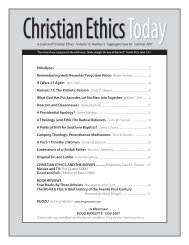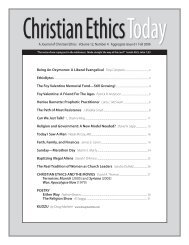Red-Letter Christians, An Emerging Evangelical Center, And Public ...
Red-Letter Christians, An Emerging Evangelical Center, And Public ...
Red-Letter Christians, An Emerging Evangelical Center, And Public ...
Create successful ePaper yourself
Turn your PDF publications into a flip-book with our unique Google optimized e-Paper software.
Servant-Leadership: Path to Organizational Health<br />
By Charles Luke, Creative Learning Consulting, Stephenville, Texas.<br />
In 1970 Robert K. Greenleaf1 coined<br />
the term ‘servant-leader’ in an essay<br />
entitled ‘The Servant as Leader.’ In<br />
essence, Greenleaf stated, the servantleader<br />
is servant first and then discovers<br />
through a desire to help others the<br />
natural choice to lead them in appropriate,<br />
healthy ways. This desire does<br />
not spring from a wish to be personally<br />
benefited. The servant-leader is<br />
different from the traditional leader in<br />
that he is not attempting to assuage<br />
some need for power or to acquire<br />
material possessions. For a biblical<br />
example of servant-leadership we need<br />
only to turn to Matthew 20:26-28 in<br />
the New Testament. In that passage<br />
Jesus describes servant-leadership by<br />
saying, ‘Whoever wants to be great<br />
among you must be your servant, and<br />
whoever wants to be first among you<br />
must be your slave, just as the Son of<br />
Man did not come to be saved, but to<br />
serve and to give his life as a ransom<br />
for many.’<br />
In discussing the difference between<br />
the leader-first and the servant-leader<br />
model, Greenleaf goes on to say that:<br />
‘The difference manifests itself in the<br />
care taken by the servant-first to make<br />
sure that other people’s highest priority<br />
needs are being served. The best<br />
test, and difficult to administer, is: do<br />
those served grow as persons; do they,<br />
while being served, become healthier,<br />
wiser, freer, more autonomous, more<br />
likely themselves to become servants?<br />
<strong>An</strong>d, what is the effect on the least<br />
privileged in society; will they benefit,<br />
or, at least, will they not be further<br />
deprived?’ 2<br />
Based on the example of Christ,<br />
that certainly sounds like a principle<br />
of Christian leadership. Too often,<br />
though, those in leadership positions<br />
in charitable and non-profit<br />
institutions seem to be more interested<br />
in power acquisition and personal<br />
aggrandizement than they are in<br />
ensuring equity for the least privileged<br />
<br />
among us. In another book, Greenleaf<br />
spells out some very basic traits to look<br />
for in a servant-leader. 3 He indicates<br />
that servant-leaders are interested in<br />
ten things:<br />
Listening—Servant-leaders are<br />
intensely committed to hearing what<br />
others have to say and to listening to<br />
them in order to meet their needs. A<br />
tolerance for the expression of other<br />
opinions and viewpoints is a mark of<br />
a servant-leader. Listening to others<br />
indicates that the servant-leader values<br />
the other person even when there<br />
is disagreement about what is said. A<br />
strong ability to hear others, coupled<br />
with regular periods of reflection, is a<br />
characteristic of a servant leader.<br />
Empathy—Servant-leaders are<br />
connected to those with whom they<br />
work, often to the point that they<br />
can feel what those in the organization<br />
feel. The servant-leader accepts<br />
people on a different level than their<br />
behavior often indicates and because<br />
people perceive him or her to be a<br />
feeling, caring person, they engender<br />
tremendous organizational identification<br />
among followers.<br />
Healing—A tremendous strength<br />
of servant-leaders is the ability to help<br />
others heal when hurt or broken. The<br />
true servant-leader models self-healing<br />
through his or her relationship with<br />
God. Servant-leaders seldom have to<br />
hide their blemishes but often admit<br />
them and allow healing in their own<br />
lives. The ability to help others heal<br />
leads to transformational leadership<br />
and away from transactional leadership.<br />
Awareness—The servant-leader<br />
is very self-aware as well as generally<br />
aware of his surroundings, circumstances,<br />
and the needs of others. Selfawareness<br />
enables the servant-leader to<br />
identify with the strengths and growth<br />
needs of others in the organization.<br />
Persuasion—The servant-leader<br />
persuades rather than commands. If<br />
a policy exists for which there is no<br />
reason or a limited rationale, the servant-leader<br />
is not afraid to review the<br />
policy or bring it to the forefront for<br />
reconsideration. Truth and righteousness<br />
are the servant-leader’s best methods<br />
of persuasion.<br />
Conceptualization—Servant-leaders<br />
typically are visionary. They think<br />
beyond the short-term problems facing<br />
an organization and attempt<br />
to establish long-term vision, mission,<br />
and goals for the organization.<br />
Servant-leaders often discuss the<br />
future in terms of years ahead rather<br />
than how the organization will do this<br />
year. They conceptualize realities far in<br />
advance of daily issues.<br />
Foresight—Servant-leaders are<br />
marked by an ability to understand the<br />
examples and lessons of the past, the<br />
realities and exigencies of today, and<br />
the potential and likely future consequences<br />
of decisions they and others<br />
make.<br />
Stewardship—Holding things in<br />
trust for others is critical for servantleaders.<br />
They understand that they are<br />
primary stewards of the health of the<br />
organization, the purpose of the institution,<br />
and indeed the corporate and<br />
individual welfare of those involved.<br />
Commitment to the growth of people<br />
– Servant-leaders are in the people<br />
business first and foremost. They are<br />
committed to the healthful development<br />
of individuals and to helping<br />
them grow. Servant-leaders look<br />
beyond the immediate behavior of<br />
individuals and look for long-range<br />
growth patterns to assist people in<br />
their holistic development.<br />
Building community—Servantleaders<br />
know that in order for organizations<br />
to be healthy those involved<br />
must possess a sense of belongingness<br />
within the organization; they must<br />
identify with the purpose and goals of<br />
the organization; and they must feel<br />
that they are contributing in some way












